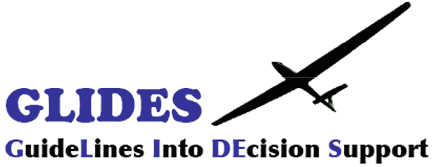|
|
|
Evaluation Plan |
Model
GLIDES Evaluation Plan
I.
Evaluation Of Transformation Of Text Guidelines Into Decision Support Plan Overview
Evaluation focuses on the feasibility and replicability
of guideline knowledge transformation, with particular attention on
recommendations for improving the quality of guideline writing
Compare Yale and Nemours: two separate approaches to
implementing the same guidelines, whose knowledge was transformed
using the same tools.
Activities
Collect,
organize, and report knowledge transformation artifacts
Evaluate
effectiveness of the GuideLine Implementability Appraisal (GLIA)
Identify
and document information that is vital for accurate and efficient
implementation
Feed
lessons learned back to guideline developers through our contacts at
professional societies and via scientific publications.
II.
Evaluation Of CDS Tool Development And Implementation
Evaluate: design and development process/activities;
quantity and quality of end-user input; degree to which each
decision support system meets requirements; implementation process;
barriers encountered (technical, cultural, design, workflow); and
solutions to barriers.
Activities
Record,
at each site, the technical barriers encountered in the codification
of recommendations in each EHR system
Collect,
categorize and report problems in codifying guideline concepts and
embedding them in the vendors’ EHR products
Record
lessons learned related to the design of clinical decision support
tools
Feed
lessons learned back to guideline developers through our contacts at
professional societies and via scientific publications.
Retain
and evaluate training manuals and materials
Prepare
recommendations for the implementation community.
III.
Evaluation Of Usability And Clinician Use Of CDS
Evaluate use of the clinical decision support systems
by clinicians in practice, including frequency and timing of use,
workflow context, clinician workarounds and avoidance, clinician
feedback and recommendations, and overall satisfaction with the
systems.
Activities
Obtain
information through structured queries of CIS, clinician surveys,
direct observation, and structured interviews with key stakeholders
Observe
clinicians in practice and interview clinicians about their use of
the system
Survey
clinicians to determine overall perceptions of guidelines and CDS
(one year after implementation)
Query
clinical information system to obtain data about usage by clinicians
IV.
Evaluation Of Effect Of CDS On Guideline-Adherent Care
Activities
Assess
quantitative metrics of guideline adherence
Derive
qualitative data through chart reviews, surveys, interviews and
direct observation
Obtain
post-intervention metrics at least 6 months after intervention
Apply
contingency tables, multivariable models, hierarchical modeling,
mixed effects logistic models,
Explore
the rate of racial/ethnic disparity in these outcomes
V.
Evaluation of Patient Outcomes
Evaluate the effect of the system on patient outcomes,
comparing one year of pre-intervention data to one year of
post-intervention data
This portion of the evaluation is not slated to begin
until 1 full year post-implementation at each site and may therefore
not take place if the contract ends as specified.
Activities
Assess
rate of asthma-related hospitalizations and ED visits to the study
institution (for asthma cohort only)
Assess
average asthma control level (asthma cohort only)
Assess
number of visits/year per patient (asthma cohort only)
Assess
Number of oral steroid courses per patient per year (asthma cohort
only)
Assess
BMI (for obesity cohort only)
Assess
“5-2-1-0” improvement (i.e., counseling re: ≥5
portions fruit and vegetables daily, ≤2 hours screen time, ≥1
hrs activity/d, and near 0 sugar-sweetened beverages collected as
yes/no
|
|

